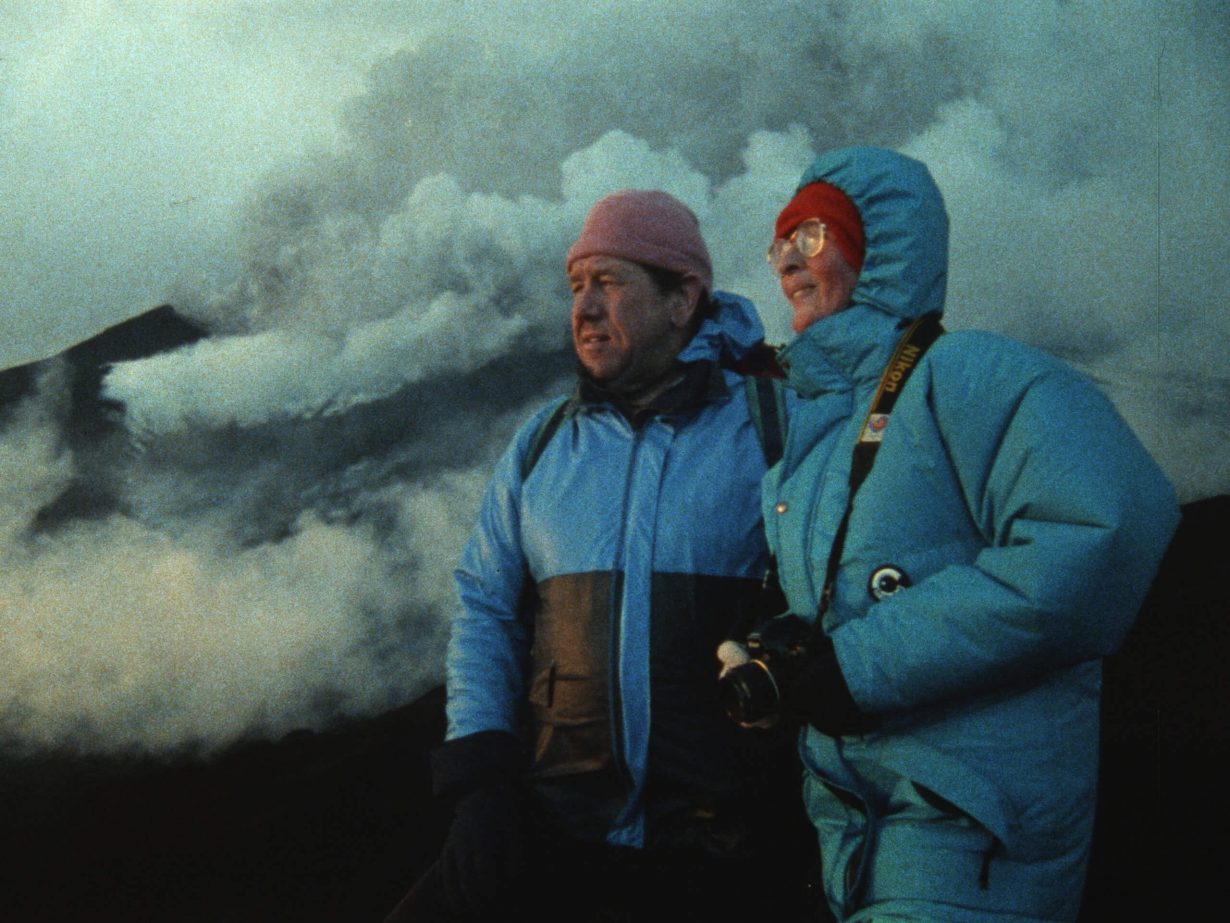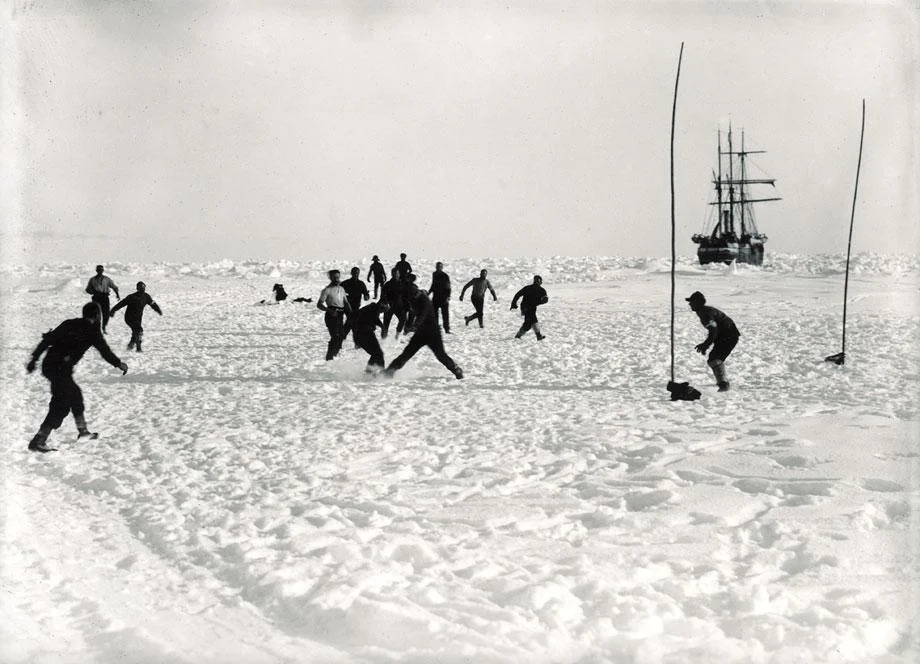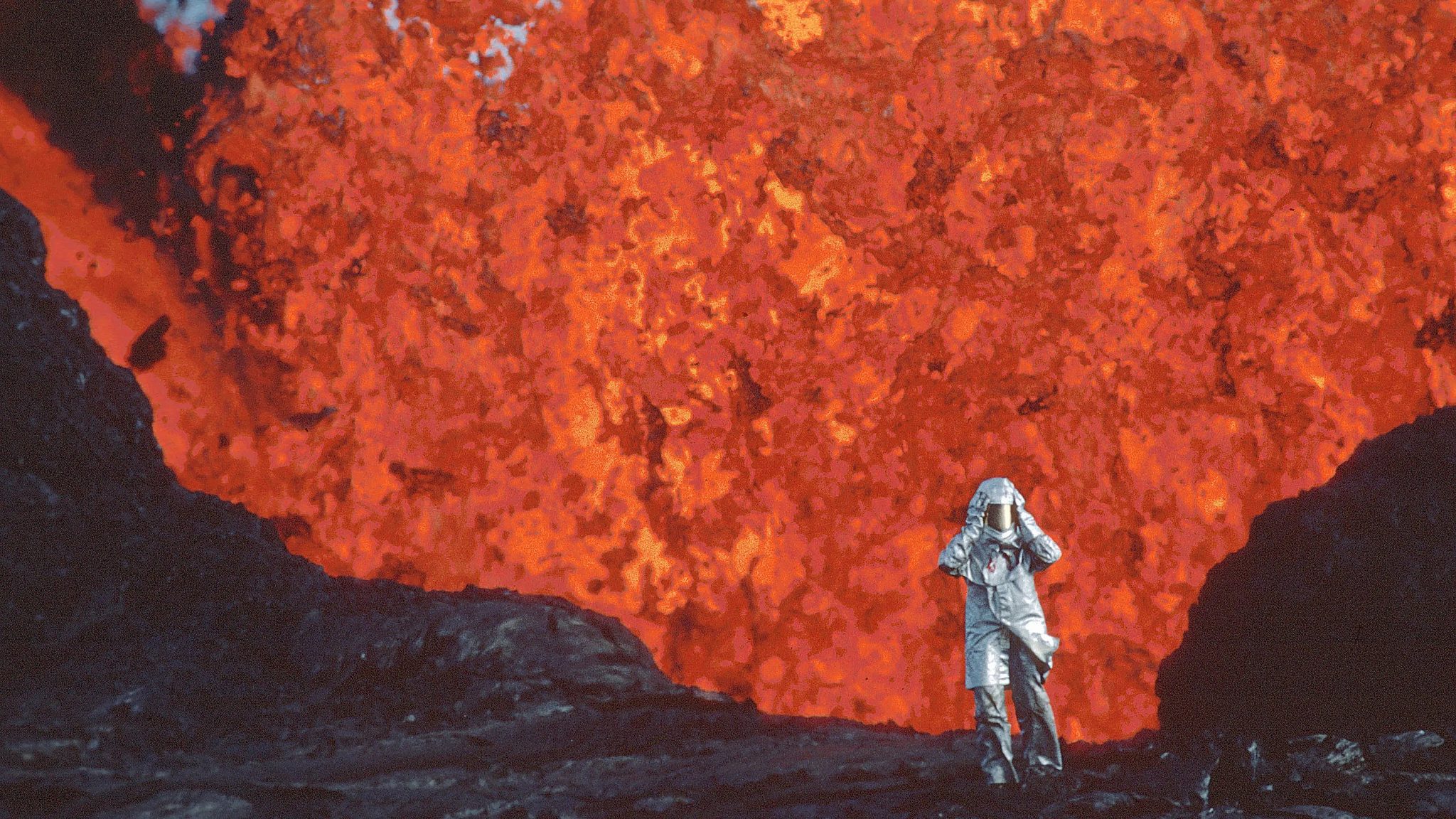The recent documentary Fire of Love is the latest in a line of works charting our fixation with – and co-option of – the volatile natural world
In the 1970s and 80s, the French couple Katia and Maurice Krafft were as famous – and as media-savvy – as other scientist-explorers Jacques Cousteau and Carl Sagan, making films that attempted to get to the hearts of volcanoes all over the world, from Iceland to Indonesia. Fire of Love (2022), directed by Sara Dosa and narrated by Miranda July, is constructed almost entirely from archival footage shot by the volcanologists as they raced from one erupting volcano to the next. This is science as spectacle, as choreography. With their rivers of flaming orange lava, the so-called ‘red’ volcanoes are more photogenic than the ‘grey’ ones. But the latter are far deadlier, emitting plumes of asphyxiating dust and toxic gas. The volcanic association with death is inevitable; we know the ability of lava and ash to kill, to freeze-frame life in places such as Pompeii, and we’re told at the start of the film that the Kraffts will pay for their obsession with their lives.

Although the ostensible reason for the Kraffts’ expeditions was their scientific desire to discover just what triggers a volcano, there is little actual science in this documentary. Rather, we’re repeatedly made aware of the tremendous physical effort that is required to travel to volcanoes: we watch the couple hike across rivers of just-set lava, mud or ash, pushing broken-down cars across iced-over slopes, and setting up their tents in newly-formed and still-smoking craters. These shots of the Kraffts’ struggles are contrasted with those of volcanoes spouting lava high into the air and emitting vast clouds that resemble those caused by atomic bombs. Larger-than-life spectacle is juxtaposed with larger-than-life characters; the couple appear fearless and comfortably acknowledge the lethal risk of their work. Perhaps they had a death wish, and in the end that wish was fulfilled when they visited the Unzen volcano in Japan in 1991.

Recurring shots of the Kraffts silhouetted against backdrops of volcanoes have a similar visual composition to Casper David Friedrich’s Wanderer Above a Sea of Fog (1818); this ubiquitous image – of the archetypal romantic encounter between the lone explorer and a vast, inhospitable landscape – was painted soon after the so-called ‘year without a summer’ caused by the eruption of Mount Tambora in Indonesia that led to global agricultural failure and subsequent famines. A reaction to the Industrial Revolution and the concomitant rise of science, the Romantic movement developed into an insistent reminder that human emotion is as valid a response to the natural world as measuring instruments and devices. But Romanticism itself was eventually co-opted by scientific expeditions in their use of photographs and moving images to show researchers struggling against the awe and might of the indifferent planet. The leaders of so-called ‘Heroic era’ British Antarctic exploration in the early twentieth century relied on science to justify their expeditions, and also used images of men struggling over the vast inhospitable landscapes of ice and snow to raise publicity. When Shackleton planned his 1914 expedition group he cannily included the photographer Frank Hurley, accurately assuming that the subsequent film footage would help boost the interest of the public – and their willingness to contribute money. Hurley’s film South (1919) showing the ship Endurance dramatically crushed by pack ice as Shackleton and his team played football was indeed enormously popular with post-WWI audiences.

In a documentary that sometimes struggles to differentiate one volcano from another, the turning point of Fire of Love is the 1985 Nevado del Ruiz tragedy. Although the Columbian Government had been warned by scientists about the impending eruption just weeks beforehand, they failed to pass on these warnings – 23,000 people died in mudflows and landslides caused by the volcano. After this, the Kraffts seemed to move towards a more collaborative approach to their work, helping to develop early warning systems that were practical to implement.
It feels appropriate that Fire of Love is made from archival footage, inspiring a nostalgia for the way that the natural world was presented decades ago. (And the fixation is set to continue, with the recent news of Werner Herzog’s forthcoming documentary, The Fire Within: A Requiem for Katia and Maurice Krafft.) Images of awesome nature still grab our attention but our relationship with the planet is increasingly complex: we can no longer pretend that we’re simply passive spectators of natural wonder; we have somewhere along the line become active agents. Who wants to watch a forest fire shooting flames high into the sky or a river bursting its banks, in the knowledge that these spectacles are caused by the climate catastrophe? Our relationship with what we see in the natural world has been irrevocably altered as we fully understand the effects of the Industrial Revolution. In turn, the requirement for awe and vastness, and a more straightforward emotional response is now satisfied by images from outer space; a region still (largely) untouched by humans. And perhaps the most touching image in Fire of Love is small-scale, a close-up of a human hand gently caressing the earth.
